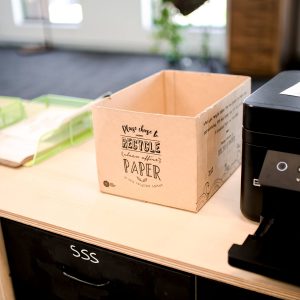
May 29, 2014
Talking To Experts – Recycling In The Corporate Environment
 Many of us are working passionately to change our corporate culture and improve the sustainability of our organisations. However at times, seemingly simple processes such as rolling out a new centralised recycling system, which can promise such significant benefits in terms of environmental and business outcomes, can leave staff whispering with discontent around the water cooler.
Many of us are working passionately to change our corporate culture and improve the sustainability of our organisations. However at times, seemingly simple processes such as rolling out a new centralised recycling system, which can promise such significant benefits in terms of environmental and business outcomes, can leave staff whispering with discontent around the water cooler.
We decided to talk to an expert to get tips on how to successfully achieve behavioural change when implementing a new recycling program in the corporate environment.
Chris Adekunle is a consultant with Waste Audit and Consultancy Services, a consultancy firm with over 20 years’ experience specialising in assisting clients to create sustainable and cost effective waste solutions. Chris is currently working with some of Australia’s best known brands, across a diverse range of industries from banking to retail leisure precincts. From initial audit, program development and implementation, Chris has significant experience implementing effective waste management programs which deliver both environmental and business outcomes.
Chris was not surprised when we initially presented him with some alarming research about change that we had gathered in preparation for our meeting. Alarmingly, research into behavioural change and change management consistently suggests that change interventions are only successful a third of the time. In fact a major 20 year study by Pooras and Robertson actually concluded that change interventions had a negative impact 10% of the time, no impact 53% of the time and a positive impact only 37% of the time. In modern governments and organisations it sometimes seems like there is an endless stream of communications about changes, with different programs being launched, gaining popularity, then dying away, only to sometimes reappear with different names.
So how do you successfully implement a recycling program and achieve behavioural change in such a context? Chris suggests having clarity about the program drivers is an essential first step which you can then build on.
“When Waste Audit Consultancy is brought in to assist a corporate office in implementing a recycling program it is likely as a result of one of two things:
1. Someone within the company (usually their sustainability or facilities management team) wants to do it as part of their performance objectives – CHANGE FROM WITHIN.
2. It’s a decision stemming from the companies own vision of itself and how they want to represent themselves to the public – CHANGE FROM ABOVE.
Both drivers are absolutely valid, and if the resources and will power are available, both can be positive drivers in the implementation of a successful sustainable program.
However implementing a recycling program can only be a success if the program is adopted by all those it aims to impact. Often this can require an element of forced compliance, which does at times require an authoritarian leadership approach, more associated with change driven from above.
 Chris provided some insightful examples of the type of challenges in which this more authoritarian leadership is required. A classic example is in the implementation of a zero bin system (that is the removal of all under desk waste bins and paper recycling boxes, which are replaced by centralised recycling bin banks in select locations). This can initially be unpopular with some team members who are unhappy with the loss of their personal bin, even though the environmental and business benefits of such a shift can be significant. Similarly, changing the behaviour of a lawyer whose time is literally worth hundreds of dollars an hour to take a few moments to walk the necessary distance to the bin banks to dispose of recycling, is not something that can be easily resolved if the leadership team are not completely on-board.
Chris provided some insightful examples of the type of challenges in which this more authoritarian leadership is required. A classic example is in the implementation of a zero bin system (that is the removal of all under desk waste bins and paper recycling boxes, which are replaced by centralised recycling bin banks in select locations). This can initially be unpopular with some team members who are unhappy with the loss of their personal bin, even though the environmental and business benefits of such a shift can be significant. Similarly, changing the behaviour of a lawyer whose time is literally worth hundreds of dollars an hour to take a few moments to walk the necessary distance to the bin banks to dispose of recycling, is not something that can be easily resolved if the leadership team are not completely on-board.
Chris listed scenarios like the above as where initiatives are “most likely to fail”. So for leaders who are seeking to lead change from within, Chris believes it is absolutely critical to both get the leadership team on board, and importantly, ensure the wider team are aware of the leadership teams support.
The good news is that there is significant research into a range of benefits achieved through sustainability programs. As such, if you are driving change from within, with a little preparation, you should be able to influence your entire leadership team to get on board by targeting their goals. As an example, shifting to a ‘zero bin system’ can have significant business benefits in reduced labour costs for cleaning contactors, and less landfill can mean lower collection costs. Draft a business case and present it to those leaders focused on financials. If you are talking to the HR manager, instead provide an overview of the research available linking more sustainable business practices with higher employee engagement and reduced attrition. Sell your sustainability program as a step towards the future vision of being an employer of choice. If you are talking to your marketing team, discuss the advantages of promoting a green brand, both internally and in the market to customers and investors who are increasingly seeking more ethical purchasing and investment options.
 Once you have the leadership team engaged, it is also important to promote their support. Often the symbolic signs of support can be the most important. There are a range of simple ways of doing this, which will not require a huge commitment from the leadership team. It could be as simple as drafting an introductory email from the leader of each unit to send from their inbox introducing the program, or starting each site rollout in the leader’s office by removing their personal bins, and sending photos out of their office with the new station. Even just inviting the leader to introduce the program at a staff briefing before you talk through the details assists.
Once you have the leadership team engaged, it is also important to promote their support. Often the symbolic signs of support can be the most important. There are a range of simple ways of doing this, which will not require a huge commitment from the leadership team. It could be as simple as drafting an introductory email from the leader of each unit to send from their inbox introducing the program, or starting each site rollout in the leader’s office by removing their personal bins, and sending photos out of their office with the new station. Even just inviting the leader to introduce the program at a staff briefing before you talk through the details assists.
Of course, other proven change management strategies such as using clear simple messages, communicating the ‘why’ rather than just ‘how’, making recycling easy through well designed systems with clear instructions, and empowering local change champions are important. However as Chris asserts, “it’s having this type of leadership involvement which can deliver the type of impact needed which all employees will respond to, and so the program will achieve the type of long term behaviour change needed for success in a corporate environment.”
Do you have any tips for introducing recycling programs in the corporate environment?
